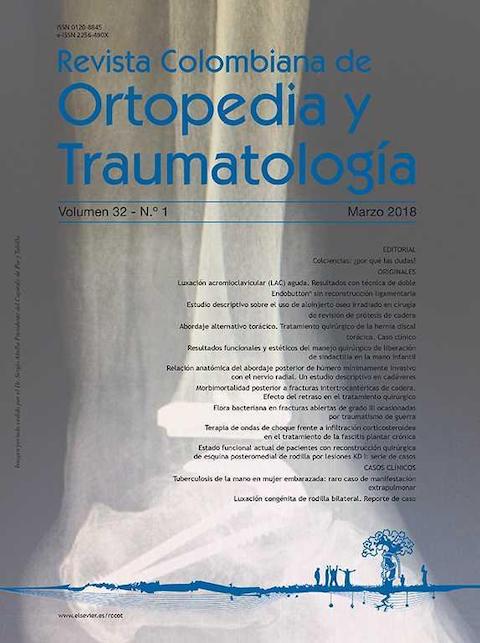Anatomical relationship of the posterior minimally invasive surgical approach of the humerus with the radial nerve. A cadaveric model study
DOI:
https://doi.org/10.1016/j.rccot.2017.07.008Keywords:
humeral shaft fractures, minimally invasive plate osteosynthesis, posterior approachAbstract
Background: It is well known that the various minimally invasive approaches described improve outcomes for the surgical fixation of diaphyseal humerus fractures. However, there is a lack of information between the anatomical relationship of the radial nerve for the required incisions or for the position of the plate when a posterior approach is used. The objective of the study is to describe the anatomical relationship of the radial nerve with both incisions of the posterior minimally invasive approach, and with the distal tip of the osteosynthesis plate.
Materials and methods: A descriptive study was performed on cadavers without trauma of upper limbs, in prone with 45º of abduction of shoulder and 90º of elbow flexion. After sliding a plate of 2.7 mm, the distances of the radial nerve with respect to the reference points of the approach and distal tip of the plate were recorded in millimetres.
Results: A mean humeral length of 286.6 mm was found. The mean distance from the lateral epicondyle to the radial nerve was 155.1 mm. The mean distance from the tricipital aponeurosis to the radial nerve was 138.9 mm, and from the distal tip of the plate to the radial nerve was 155.6 mm.
Discussion: Plate fixation using minimal invasive technique using a posterior surgical approach may be safe for diaphyseal fractures of the humerus with respect to radial nerve injuries, as long as the plate screws are located outside the range of 128.5 mm to 169.5 mm measured from the tip of the plate. Clinical studies are required to demonstrate the safety of this approach.
Evidence level: IV.
Downloads
References
Bucholz RW, Court-Brown CM, editores. Fractures of the shaft of the humerus, 6th ed. Philadelphia: Lippincott Williams and Wilkins; 2006.
Bucholz RW, Court-Brown CM. Rockwood and green's fractures in adults principles of nonoperative fracture treatment 2010.
Esmailiejah AA, Abbasian MR, Safdari F, Ashoori K. Treatment of humeral shaft fractures: Minimally invasive plate osteosynthesis versus open reduction and internal fixation. Trauma Mon. 2015;20, e26271. https://doi.org/10.5812/traumamon.26271v2
Zogaib RK, Morgan S, Belangero PS, Fernandes HJ, Belangero WD, Livani B. Minimal invasive ostheosintesis for treatment of diaphiseal transverse humeral shaft fractures. Acta Ortop Bras. 2014;22:94-8. https://doi.org/10.1590/1413-78522014220200698
Ji F, Tong D, Tang H, Cai X, Zhang Q, Li J, et al. Minimally invasive percutaneous plate osteosynthesis (MIPPO) technique applied in the treatment of humeral shaft distal fractures through a lateral approach. Int Orthop. 2009;33:543-7. https://doi.org/10.1007/s00264-008-0522-2
Gallucci G, Boretto J, Vujovich A, Alfie V, Donndorff A, De Carli P. Posterior minimally invasive plate osteosynthesis for humeral shaft fractures. Tech Hand Up Extrem Surg. 2014;18:25-30. https://doi.org/10.1097/BTH.0000000000000017
Voigt C, Illical E, Goyal KS, Farrell DJ, Van Eck CF, Tarkin IS. Cadaveric investigation on radial nerve strain using different posterior surgical exposures for extraarticular distal humeral ORIF: merits of nerve decompression through a lateral paratricipital exposure. J Orthop Trauma. 2015;29:e43-5. https://doi.org/10.1097/BOT.0000000000000204
Gallucci GL, Boretto JG, Alfie VA, Donndorff A, De Carli P. Posterior minimally invasive plate osteosynthesis (MIPO) of distal third humeral shaft fractures with segmental isolation of the radial nerve. Chir Main. 2015;34:221-6. https://doi.org/10.1016/j.main.2015.06.007
Apivatthakakul T, Patiyasikan S, Luevitoonvechkit S. Danger zone for locking screw placement in minimally invasive plate osteosynthesis (MIPO) of humeral shaft fractures: a cadaveric study. Injury. 2010;41:169-72. https://doi.org/10.1016/j.injury.2009.08.002
An Z, Zeng B, He X, Chen Q, Hu S. Plating osteosynthesis of mid-distal humeral shaft fractures: minimally invasive versus conventional open reduction technique. Int Orthop. 2010;34:131-5. https://doi.org/10.1007/s00264-009-0753-x
Downloads
Published
How to Cite
Issue
Section
License
Copyright (c) 2024 Revista Colombiana de ortopedia y traumatología

This work is licensed under a Creative Commons Attribution 3.0 Unported License.




